It is time to leave Thailand’s central plain and head for the hills which mark the beginning of Northern Thailand. We have more temples to see, more noodles to eat, and more shopping to do. Sukhothai was affected in several ways by the flooding this past Spring, but one particular change that touches our schedule is that the morning market has been moved to temporary quarters. We will visit the old market site for a traditional breakfast of wide rice noodles with roast duck, buy bags of fiery chillies, and then head over to the alternate location.
We stopped at a sidewalk restaurant and tried not to use up all of the tables and chairs. There is a large sign out front that says “Like” with the Facebook thumbs up symbol, but unless you can find the name of the shop in Thai, this wasn’t possible. Nor would Westerners necessarily like it. I missed Kasma’s introduction to the noodles, so I was a bit surprised by the large cube of blood in my soup. I received a couple blood donations in exchange for my (duck) liver, so I think everyone managed to avoid the parts about which they were most squeamish. Since we always need side dishes, we had khanom krok, sticky rice topped with a mix of granulated sugar and powered dried fish (or shrimp?), and diminutive sour sausages on skewers served with tangy ginger and hot Thai chillies for simul-munching.
While we were surveying the scene from our tables, a small woman came up carrying two enormous baskets of food on a pole across her shoulder. After pictures, she sold us what looked like doughnut holes. Inside there was some pale, sweet yellow matter that we think might have been mung bean, but we’ll probably never know for sure. They were too sweet by themselves, but eaten with a Thai chilli one could overlook that minor flaw.
We wandered briefly through a nearby market selling mostly fish and vegetables before making our way to a stand with numerous piles of chillies. Although to the untrained eye and nose these could appear very similar, we were there for a particular variety of large red chillies that are very hot. Kasma has found these to be the best for making truly red colored red curries. Apparently they are grown in India, and this little town is one of the best places to find them.
We headed across town to the relocated market, and I soon was bored. I wandered the nearby streets and found a shirt shop selling a batik of the local ruins. I can add this to my Krabi, Nakhon Si Thammart, and Songkhla-specific batik shirts.
The Road North
We will be spending two nights in Mae Rim, home to the Mae Sa Valley Resort. The weather is similar to the Bay Area in the Summer, if you were to subtract the fog: cool nights, warm sunny days. Unlike my last trip here, we are not being chased by rainstorms this year, so it should be very pleasant.
After a few hours of driving, we stopped for lunch. It’s our first bowl of Chiang Mai style curry noodles, better known as Kao Soi. Thin and properly al dente egg noodles rest in a yellow and slightly spicy broth, topped with crispy fried noodles. From a plate on the side you add picked mustard green, raw shallots, and a squeeze of lime to taste. You also can add hot oil from the communal jar of roasted chilli paste. If you’re not careful, you can make it pretty difficult to enjoy, so I kept it on the mild side today. For dessert, we had dark green “noodles” fashioned from glutinous rice, served in a sweet coconut sauce with crushed ice — just the thing to soothe a tongue “burned” by spicy Kao Soi. Fresh bananas followed for good measure.
Lampang
The architectural style of temples in Northern Thailand differs from those further South. In Lampang, the temples are described as Lanna-style. In particular, there are multi-level roofs featuring teak tiles. Unfortunately, one of the original buildings is being modernized, so in future years, it may be harder to find Lanna-style buildings. I’ve described this temple in more detail in a previous post: Exploring the North (2008).

View the entire album: Wat Phra That Lampang Luang – Thailand Photos 2013
Mae Sa Valley Resort
Built into a terraced hillside that reveals its former use for rice cultivation, the resort’s vibrant flowers and picturesque cottages offer basic beds and bathrooms, lots of floor cushions, and nestles you in close to the birds and squirrels. If you are looking for nightlife, this would not be the place for you.
I had brought a bottle of tequila in my bag for our drivers to try out, but I found some other trip members first, so we had a few sips before I made my way to the lobby and discovered our drivers. I don’t know whether they are familiar with tequila, but one of the hotel employees explained to them that it usually was taken with salt and lime. It’s funny how such traditions spread.
We gathered at a table outdoors (in front of the dining room) after sundown. Everyone seemed to like the prik khing chicken with green beans (here, chopped into short lengths), a typical dry curry dish I try at all Thai restaurants. Unlike back home, they did not include excess oil from the roasted chilli paste. Chunks of sour sausage were mixed with the traditional accompaniments (whole cloves of pickled garlic, peanuts, shallots, chillies) for more efficient service. Our soup was a very peppery gaeng liang with shrimp, chicken (?), loufah squash, kabocha squash, and did I mention the white pepper? Other dishes included: mixed vegetables in mild Thai oyster sauce, crystal noodle (mung bean thread) salad, and sliced fish with sweet chilli sauce and basil (I missed the actual fish somehow). The resort serves a fruit plate with papaya, pineapple and watermelon. The fruit is not at its peak but is a nice break from sweet coconut-based dessserts.
Tomorrow we will journey up the mountain to a local Hmong village to visit Kasma’s goddaughters and enjoy the local hospitality. Buying some handicrafts also seems very likely.
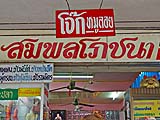
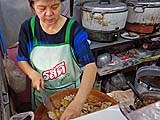
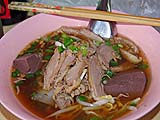
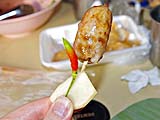
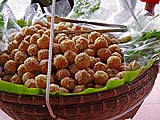

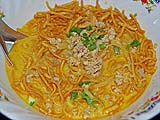
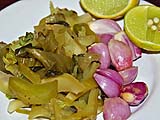
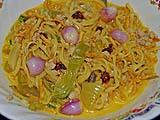
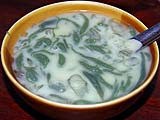
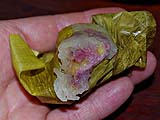
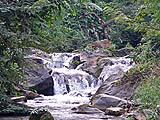
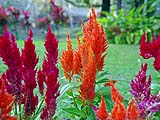
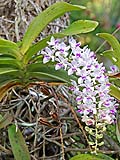
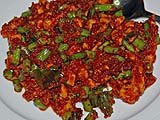
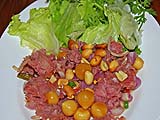
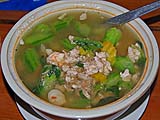
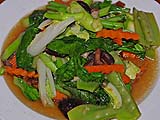
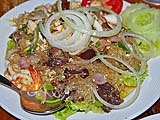
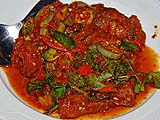
Sorry, the comment form is closed at this time.